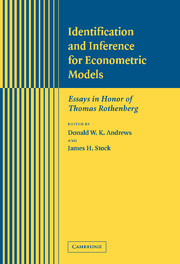Book contents
- Frontmatter
- Contents
- List of Contributors
- Preface
- Part I Identification and Efficient Estimation
- 1 Incredible Structural Inference
- 2 Structural Equation Models in Human Behavior Genetics
- 3 Unobserved Heterogeneity and Estimation of Average Partial Effects
- 4 On Specifying Graphical Models for Causation and the Identification Problem
- 5 Testing for Weak Instruments in Linear IV Regression
- 6 Asymptotic Distributions of Instrumental Variables Statistics with Many Instruments
- 7 Identifying a Source of Financial Volatility
- Part II Asymptotic Approximations
- Part III Inference Involving Potentially Nonstationary Time Series
- Part IV Nonparametric and Semiparametric Inference
3 - Unobserved Heterogeneity and Estimation of Average Partial Effects
Published online by Cambridge University Press: 24 February 2010
- Frontmatter
- Contents
- List of Contributors
- Preface
- Part I Identification and Efficient Estimation
- 1 Incredible Structural Inference
- 2 Structural Equation Models in Human Behavior Genetics
- 3 Unobserved Heterogeneity and Estimation of Average Partial Effects
- 4 On Specifying Graphical Models for Causation and the Identification Problem
- 5 Testing for Weak Instruments in Linear IV Regression
- 6 Asymptotic Distributions of Instrumental Variables Statistics with Many Instruments
- 7 Identifying a Source of Financial Volatility
- Part II Asymptotic Approximations
- Part III Inference Involving Potentially Nonstationary Time Series
- Part IV Nonparametric and Semiparametric Inference
Summary
ABSTRACT
I study the problem of identifying average partial effects (APEs), which are partial effects averaged across the population distribution of unobserved heterogeneity, under different assumptions. One possibility is that the unobserved heterogeneity is conditionally independent of the observed covariates. When the unobserved heterogeneity is independent of the original covariates, or conditional mean independent but heteroskedastic, the derivations of APEs provide a new view of traditional specification problems in widely used models such as probit and Tobit. In addition, the focus on average partial effects resolves scaling issues that arise in estimating the parameters of probit and Tobit models with endogenous explanatory variables.
INTRODUCTION
Econometric models, especially at the individual, family, or firm level, are often specified to depend on unobserved heterogeneity in addition to observable covariates. Models with unobserved heterogeneity are sometimes derived from economic theory; at other times they are based on introspection.
In nonlinear models, much has been made about the deleterious effects that ignoring heterogeneity can have on the estimation of parameters, even when the heterogeneity is assumed to be independent of the observed covariates. A leading case is the probit model with an omitted variable. Yatchew and Griliches (1985) show that when the omitted variable is independent of the explanatory variables and normally distributed, the probit estimators suffer from (asymptotic) attenuation bias. This result is sometimes cited to illustrate how a misspecification that is innocuous in linear models leads to problems in nonlinear models (see, for example, Greene [2000, p. 828]).
- Type
- Chapter
- Information
- Identification and Inference for Econometric ModelsEssays in Honor of Thomas Rothenberg, pp. 27 - 55Publisher: Cambridge University PressPrint publication year: 2005
- 37
- Cited by



